Analysis of Online Privacy, Digital Security, and Loyalty Programs
VerifiedAdded on 2020/05/28
|6
|1944
|44
Report
AI Summary
This report delves into the complexities of online privacy, digital security, and the implications of loyalty programs on personal data. It examines the Australian Privacy Principles (APP) and compares them with the European Union's General Data Protection Regulation (GDPR). The report highlights the importance of digital preservation, emphasizing the threats to digital materials and the need for proactive measures like regular data checks, secure storage, and understanding data dependencies. It also provides practical advice on safeguarding personal information, including securing email accounts, using VPNs, and enabling two-factor authentication. The report emphasizes the shared responsibility for protecting privacy, particularly for those using credit cards and loyalty programs, while also acknowledging the evolving nature of cyber threats and the need for updated legislation to counter these challenges.

1
Online Privacy
Online Privacy
Paraphrase This Document
Need a fresh take? Get an instant paraphrase of this document with our AI Paraphraser
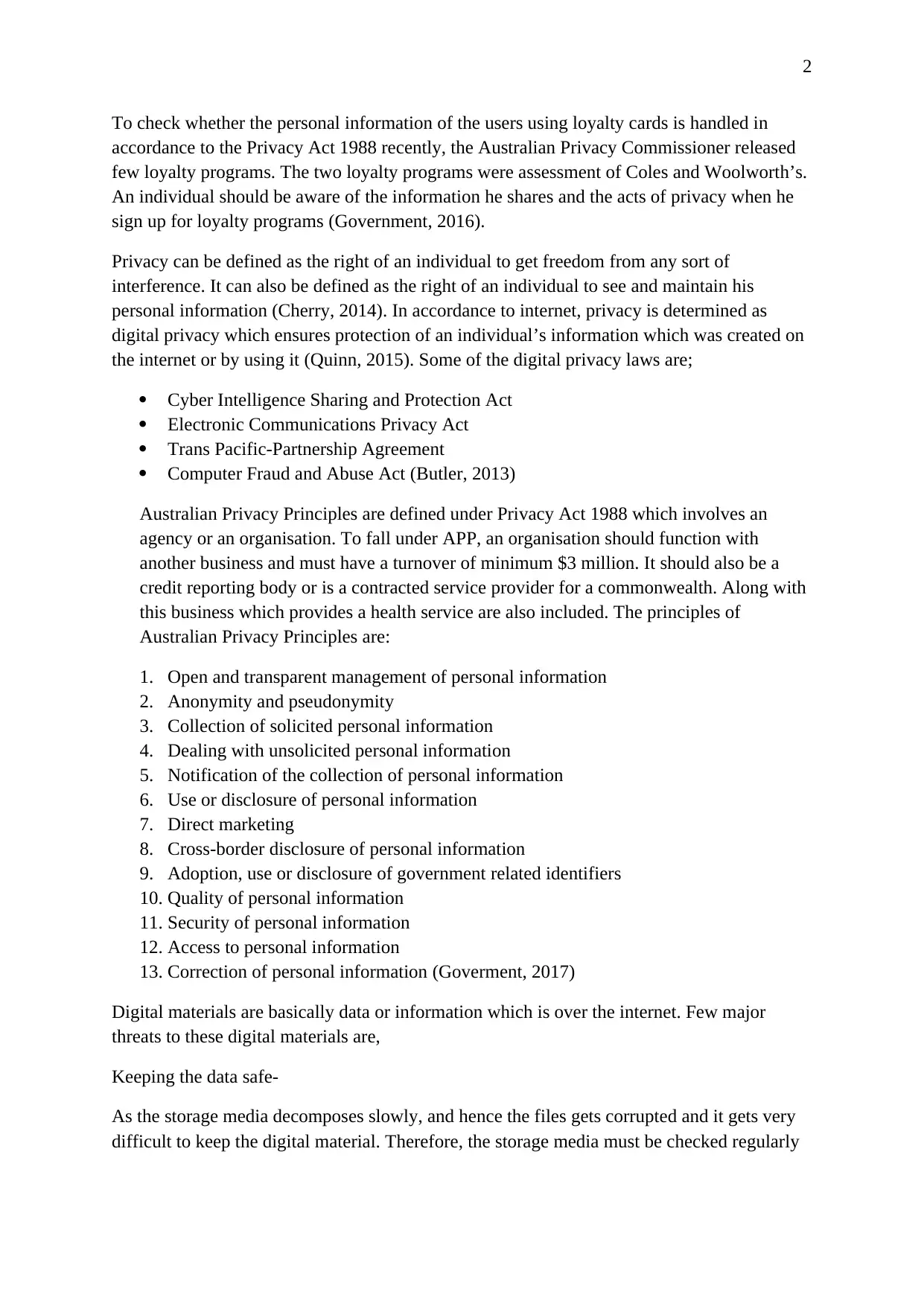
2
To check whether the personal information of the users using loyalty cards is handled in
accordance to the Privacy Act 1988 recently, the Australian Privacy Commissioner released
few loyalty programs. The two loyalty programs were assessment of Coles and Woolworth’s.
An individual should be aware of the information he shares and the acts of privacy when he
sign up for loyalty programs (Government, 2016).
Privacy can be defined as the right of an individual to get freedom from any sort of
interference. It can also be defined as the right of an individual to see and maintain his
personal information (Cherry, 2014). In accordance to internet, privacy is determined as
digital privacy which ensures protection of an individual’s information which was created on
the internet or by using it (Quinn, 2015). Some of the digital privacy laws are;
Cyber Intelligence Sharing and Protection Act
Electronic Communications Privacy Act
Trans Pacific-Partnership Agreement
Computer Fraud and Abuse Act (Butler, 2013)
Australian Privacy Principles are defined under Privacy Act 1988 which involves an
agency or an organisation. To fall under APP, an organisation should function with
another business and must have a turnover of minimum $3 million. It should also be a
credit reporting body or is a contracted service provider for a commonwealth. Along with
this business which provides a health service are also included. The principles of
Australian Privacy Principles are:
1. Open and transparent management of personal information
2. Anonymity and pseudonymity
3. Collection of solicited personal information
4. Dealing with unsolicited personal information
5. Notification of the collection of personal information
6. Use or disclosure of personal information
7. Direct marketing
8. Cross-border disclosure of personal information
9. Adoption, use or disclosure of government related identifiers
10. Quality of personal information
11. Security of personal information
12. Access to personal information
13. Correction of personal information (Goverment, 2017)
Digital materials are basically data or information which is over the internet. Few major
threats to these digital materials are,
Keeping the data safe-
As the storage media decomposes slowly, and hence the files gets corrupted and it gets very
difficult to keep the digital material. Therefore, the storage media must be checked regularly
To check whether the personal information of the users using loyalty cards is handled in
accordance to the Privacy Act 1988 recently, the Australian Privacy Commissioner released
few loyalty programs. The two loyalty programs were assessment of Coles and Woolworth’s.
An individual should be aware of the information he shares and the acts of privacy when he
sign up for loyalty programs (Government, 2016).
Privacy can be defined as the right of an individual to get freedom from any sort of
interference. It can also be defined as the right of an individual to see and maintain his
personal information (Cherry, 2014). In accordance to internet, privacy is determined as
digital privacy which ensures protection of an individual’s information which was created on
the internet or by using it (Quinn, 2015). Some of the digital privacy laws are;
Cyber Intelligence Sharing and Protection Act
Electronic Communications Privacy Act
Trans Pacific-Partnership Agreement
Computer Fraud and Abuse Act (Butler, 2013)
Australian Privacy Principles are defined under Privacy Act 1988 which involves an
agency or an organisation. To fall under APP, an organisation should function with
another business and must have a turnover of minimum $3 million. It should also be a
credit reporting body or is a contracted service provider for a commonwealth. Along with
this business which provides a health service are also included. The principles of
Australian Privacy Principles are:
1. Open and transparent management of personal information
2. Anonymity and pseudonymity
3. Collection of solicited personal information
4. Dealing with unsolicited personal information
5. Notification of the collection of personal information
6. Use or disclosure of personal information
7. Direct marketing
8. Cross-border disclosure of personal information
9. Adoption, use or disclosure of government related identifiers
10. Quality of personal information
11. Security of personal information
12. Access to personal information
13. Correction of personal information (Goverment, 2017)
Digital materials are basically data or information which is over the internet. Few major
threats to these digital materials are,
Keeping the data safe-
As the storage media decomposes slowly, and hence the files gets corrupted and it gets very
difficult to keep the digital material. Therefore, the storage media must be checked regularly
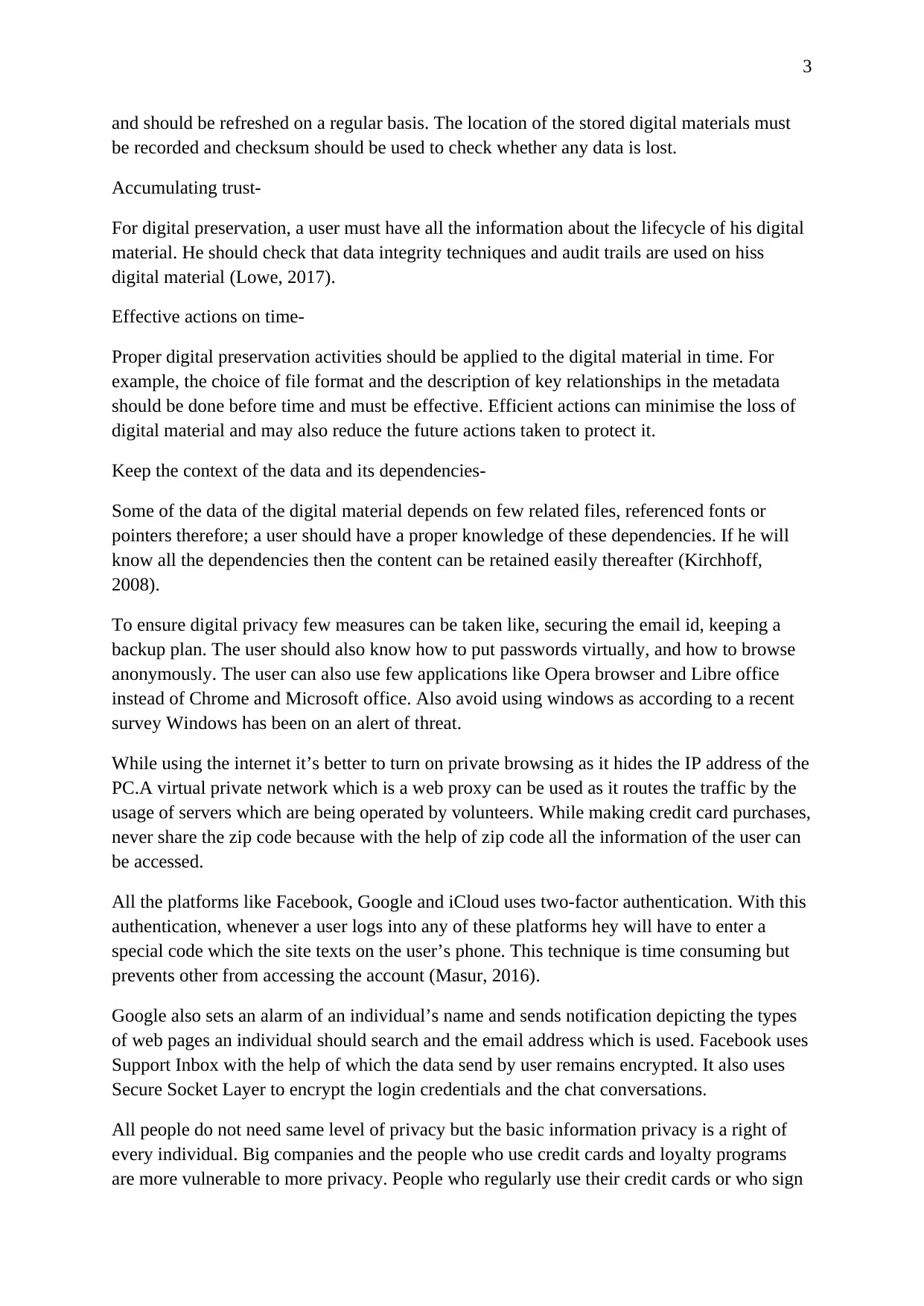
3
and should be refreshed on a regular basis. The location of the stored digital materials must
be recorded and checksum should be used to check whether any data is lost.
Accumulating trust-
For digital preservation, a user must have all the information about the lifecycle of his digital
material. He should check that data integrity techniques and audit trails are used on hiss
digital material (Lowe, 2017).
Effective actions on time-
Proper digital preservation activities should be applied to the digital material in time. For
example, the choice of file format and the description of key relationships in the metadata
should be done before time and must be effective. Efficient actions can minimise the loss of
digital material and may also reduce the future actions taken to protect it.
Keep the context of the data and its dependencies-
Some of the data of the digital material depends on few related files, referenced fonts or
pointers therefore; a user should have a proper knowledge of these dependencies. If he will
know all the dependencies then the content can be retained easily thereafter (Kirchhoff,
2008).
To ensure digital privacy few measures can be taken like, securing the email id, keeping a
backup plan. The user should also know how to put passwords virtually, and how to browse
anonymously. The user can also use few applications like Opera browser and Libre office
instead of Chrome and Microsoft office. Also avoid using windows as according to a recent
survey Windows has been on an alert of threat.
While using the internet it’s better to turn on private browsing as it hides the IP address of the
PC.A virtual private network which is a web proxy can be used as it routes the traffic by the
usage of servers which are being operated by volunteers. While making credit card purchases,
never share the zip code because with the help of zip code all the information of the user can
be accessed.
All the platforms like Facebook, Google and iCloud uses two-factor authentication. With this
authentication, whenever a user logs into any of these platforms hey will have to enter a
special code which the site texts on the user’s phone. This technique is time consuming but
prevents other from accessing the account (Masur, 2016).
Google also sets an alarm of an individual’s name and sends notification depicting the types
of web pages an individual should search and the email address which is used. Facebook uses
Support Inbox with the help of which the data send by user remains encrypted. It also uses
Secure Socket Layer to encrypt the login credentials and the chat conversations.
All people do not need same level of privacy but the basic information privacy is a right of
every individual. Big companies and the people who use credit cards and loyalty programs
are more vulnerable to more privacy. People who regularly use their credit cards or who sign
and should be refreshed on a regular basis. The location of the stored digital materials must
be recorded and checksum should be used to check whether any data is lost.
Accumulating trust-
For digital preservation, a user must have all the information about the lifecycle of his digital
material. He should check that data integrity techniques and audit trails are used on hiss
digital material (Lowe, 2017).
Effective actions on time-
Proper digital preservation activities should be applied to the digital material in time. For
example, the choice of file format and the description of key relationships in the metadata
should be done before time and must be effective. Efficient actions can minimise the loss of
digital material and may also reduce the future actions taken to protect it.
Keep the context of the data and its dependencies-
Some of the data of the digital material depends on few related files, referenced fonts or
pointers therefore; a user should have a proper knowledge of these dependencies. If he will
know all the dependencies then the content can be retained easily thereafter (Kirchhoff,
2008).
To ensure digital privacy few measures can be taken like, securing the email id, keeping a
backup plan. The user should also know how to put passwords virtually, and how to browse
anonymously. The user can also use few applications like Opera browser and Libre office
instead of Chrome and Microsoft office. Also avoid using windows as according to a recent
survey Windows has been on an alert of threat.
While using the internet it’s better to turn on private browsing as it hides the IP address of the
PC.A virtual private network which is a web proxy can be used as it routes the traffic by the
usage of servers which are being operated by volunteers. While making credit card purchases,
never share the zip code because with the help of zip code all the information of the user can
be accessed.
All the platforms like Facebook, Google and iCloud uses two-factor authentication. With this
authentication, whenever a user logs into any of these platforms hey will have to enter a
special code which the site texts on the user’s phone. This technique is time consuming but
prevents other from accessing the account (Masur, 2016).
Google also sets an alarm of an individual’s name and sends notification depicting the types
of web pages an individual should search and the email address which is used. Facebook uses
Support Inbox with the help of which the data send by user remains encrypted. It also uses
Secure Socket Layer to encrypt the login credentials and the chat conversations.
All people do not need same level of privacy but the basic information privacy is a right of
every individual. Big companies and the people who use credit cards and loyalty programs
are more vulnerable to more privacy. People who regularly use their credit cards or who sign
⊘ This is a preview!⊘
Do you want full access?
Subscribe today to unlock all pages.

Trusted by 1+ million students worldwide
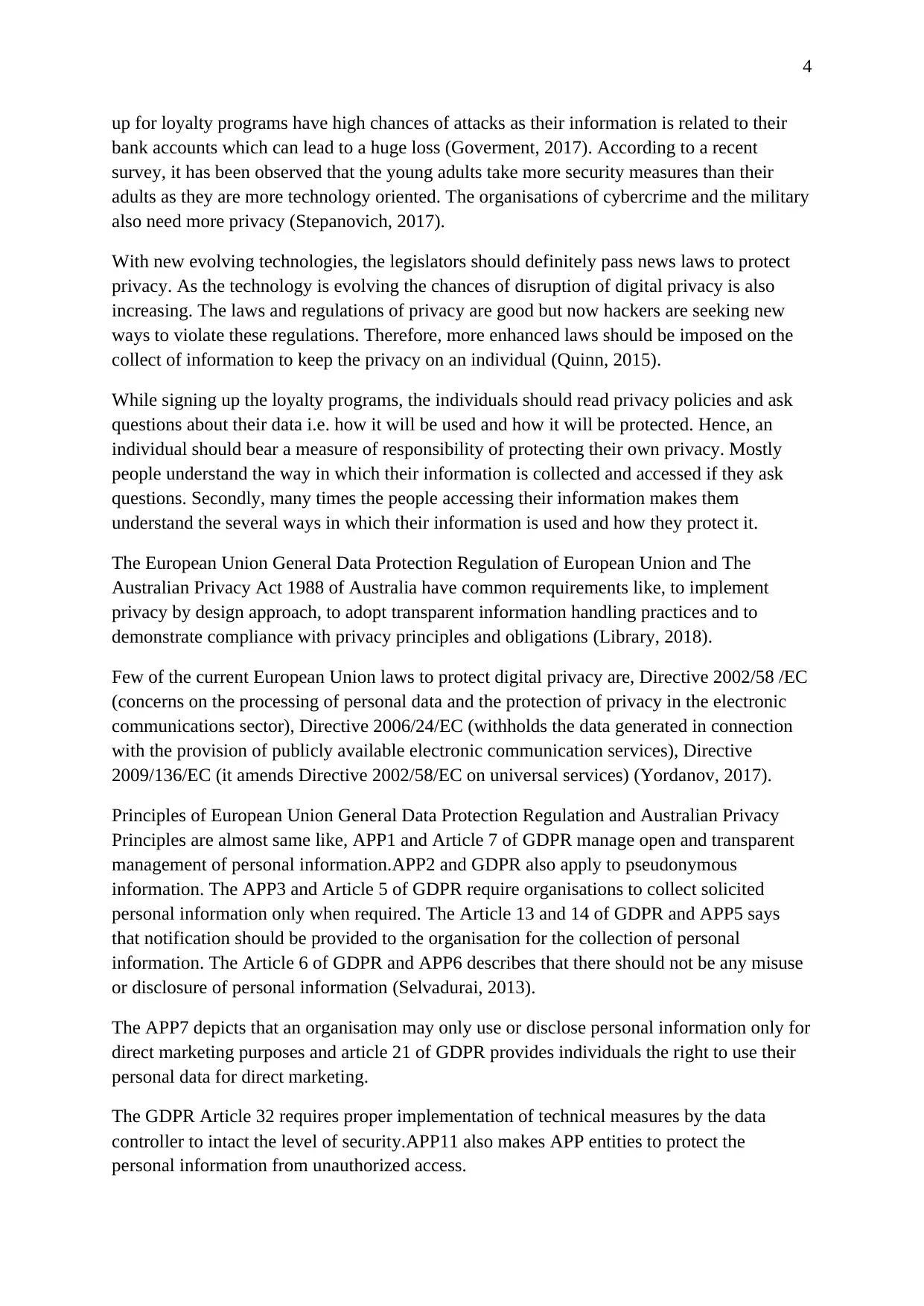
4
up for loyalty programs have high chances of attacks as their information is related to their
bank accounts which can lead to a huge loss (Goverment, 2017). According to a recent
survey, it has been observed that the young adults take more security measures than their
adults as they are more technology oriented. The organisations of cybercrime and the military
also need more privacy (Stepanovich, 2017).
With new evolving technologies, the legislators should definitely pass news laws to protect
privacy. As the technology is evolving the chances of disruption of digital privacy is also
increasing. The laws and regulations of privacy are good but now hackers are seeking new
ways to violate these regulations. Therefore, more enhanced laws should be imposed on the
collect of information to keep the privacy on an individual (Quinn, 2015).
While signing up the loyalty programs, the individuals should read privacy policies and ask
questions about their data i.e. how it will be used and how it will be protected. Hence, an
individual should bear a measure of responsibility of protecting their own privacy. Mostly
people understand the way in which their information is collected and accessed if they ask
questions. Secondly, many times the people accessing their information makes them
understand the several ways in which their information is used and how they protect it.
The European Union General Data Protection Regulation of European Union and The
Australian Privacy Act 1988 of Australia have common requirements like, to implement
privacy by design approach, to adopt transparent information handling practices and to
demonstrate compliance with privacy principles and obligations (Library, 2018).
Few of the current European Union laws to protect digital privacy are, Directive 2002/58 /EC
(concerns on the processing of personal data and the protection of privacy in the electronic
communications sector), Directive 2006/24/EC (withholds the data generated in connection
with the provision of publicly available electronic communication services), Directive
2009/136/EC (it amends Directive 2002/58/EC on universal services) (Yordanov, 2017).
Principles of European Union General Data Protection Regulation and Australian Privacy
Principles are almost same like, APP1 and Article 7 of GDPR manage open and transparent
management of personal information.APP2 and GDPR also apply to pseudonymous
information. The APP3 and Article 5 of GDPR require organisations to collect solicited
personal information only when required. The Article 13 and 14 of GDPR and APP5 says
that notification should be provided to the organisation for the collection of personal
information. The Article 6 of GDPR and APP6 describes that there should not be any misuse
or disclosure of personal information (Selvadurai, 2013).
The APP7 depicts that an organisation may only use or disclose personal information only for
direct marketing purposes and article 21 of GDPR provides individuals the right to use their
personal data for direct marketing.
The GDPR Article 32 requires proper implementation of technical measures by the data
controller to intact the level of security.APP11 also makes APP entities to protect the
personal information from unauthorized access.
up for loyalty programs have high chances of attacks as their information is related to their
bank accounts which can lead to a huge loss (Goverment, 2017). According to a recent
survey, it has been observed that the young adults take more security measures than their
adults as they are more technology oriented. The organisations of cybercrime and the military
also need more privacy (Stepanovich, 2017).
With new evolving technologies, the legislators should definitely pass news laws to protect
privacy. As the technology is evolving the chances of disruption of digital privacy is also
increasing. The laws and regulations of privacy are good but now hackers are seeking new
ways to violate these regulations. Therefore, more enhanced laws should be imposed on the
collect of information to keep the privacy on an individual (Quinn, 2015).
While signing up the loyalty programs, the individuals should read privacy policies and ask
questions about their data i.e. how it will be used and how it will be protected. Hence, an
individual should bear a measure of responsibility of protecting their own privacy. Mostly
people understand the way in which their information is collected and accessed if they ask
questions. Secondly, many times the people accessing their information makes them
understand the several ways in which their information is used and how they protect it.
The European Union General Data Protection Regulation of European Union and The
Australian Privacy Act 1988 of Australia have common requirements like, to implement
privacy by design approach, to adopt transparent information handling practices and to
demonstrate compliance with privacy principles and obligations (Library, 2018).
Few of the current European Union laws to protect digital privacy are, Directive 2002/58 /EC
(concerns on the processing of personal data and the protection of privacy in the electronic
communications sector), Directive 2006/24/EC (withholds the data generated in connection
with the provision of publicly available electronic communication services), Directive
2009/136/EC (it amends Directive 2002/58/EC on universal services) (Yordanov, 2017).
Principles of European Union General Data Protection Regulation and Australian Privacy
Principles are almost same like, APP1 and Article 7 of GDPR manage open and transparent
management of personal information.APP2 and GDPR also apply to pseudonymous
information. The APP3 and Article 5 of GDPR require organisations to collect solicited
personal information only when required. The Article 13 and 14 of GDPR and APP5 says
that notification should be provided to the organisation for the collection of personal
information. The Article 6 of GDPR and APP6 describes that there should not be any misuse
or disclosure of personal information (Selvadurai, 2013).
The APP7 depicts that an organisation may only use or disclose personal information only for
direct marketing purposes and article 21 of GDPR provides individuals the right to use their
personal data for direct marketing.
The GDPR Article 32 requires proper implementation of technical measures by the data
controller to intact the level of security.APP11 also makes APP entities to protect the
personal information from unauthorized access.
Paraphrase This Document
Need a fresh take? Get an instant paraphrase of this document with our AI Paraphraser
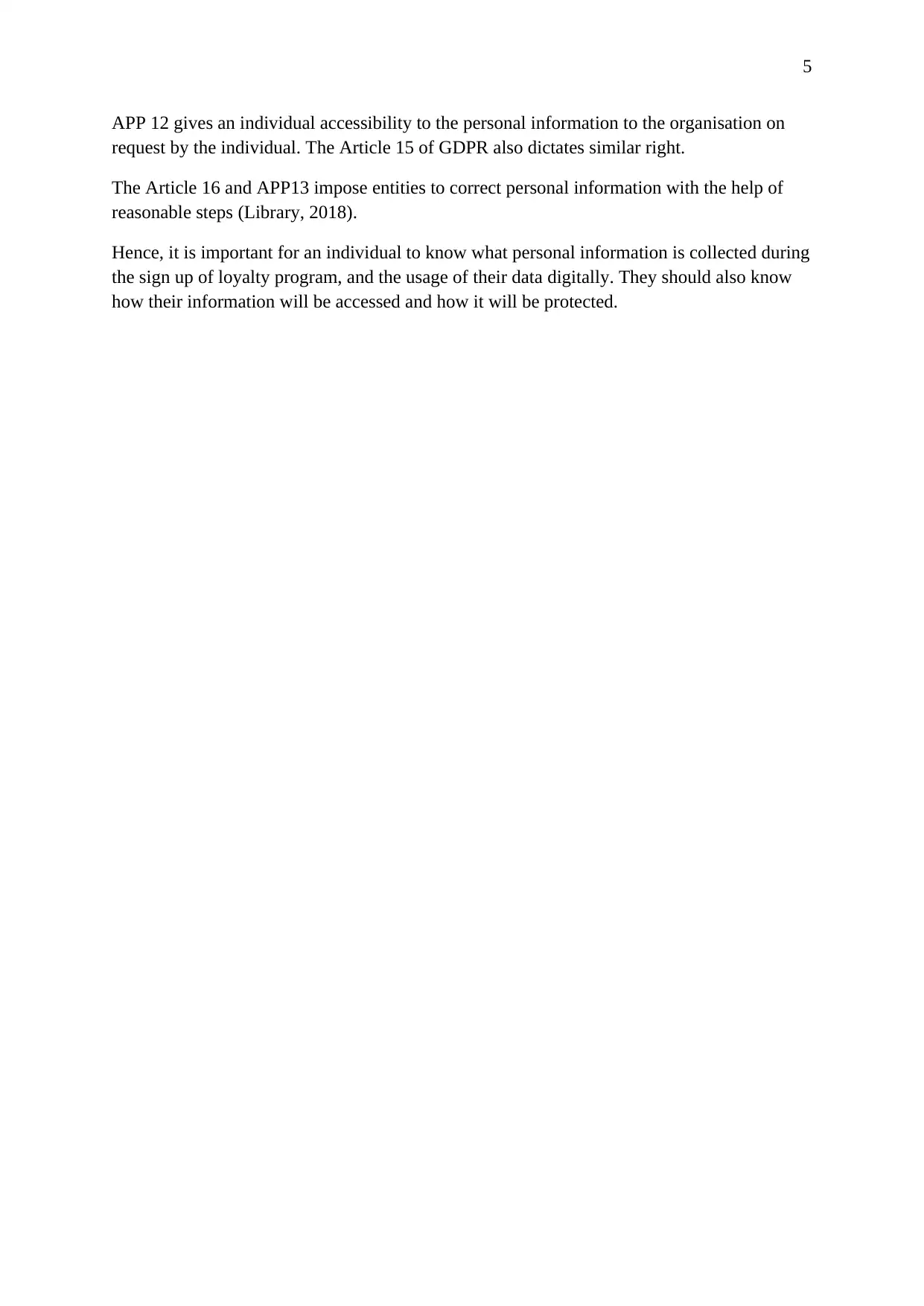
5
APP 12 gives an individual accessibility to the personal information to the organisation on
request by the individual. The Article 15 of GDPR also dictates similar right.
The Article 16 and APP13 impose entities to correct personal information with the help of
reasonable steps (Library, 2018).
Hence, it is important for an individual to know what personal information is collected during
the sign up of loyalty program, and the usage of their data digitally. They should also know
how their information will be accessed and how it will be protected.
APP 12 gives an individual accessibility to the personal information to the organisation on
request by the individual. The Article 15 of GDPR also dictates similar right.
The Article 16 and APP13 impose entities to correct personal information with the help of
reasonable steps (Library, 2018).
Hence, it is important for an individual to know what personal information is collected during
the sign up of loyalty program, and the usage of their data digitally. They should also know
how their information will be accessed and how it will be protected.
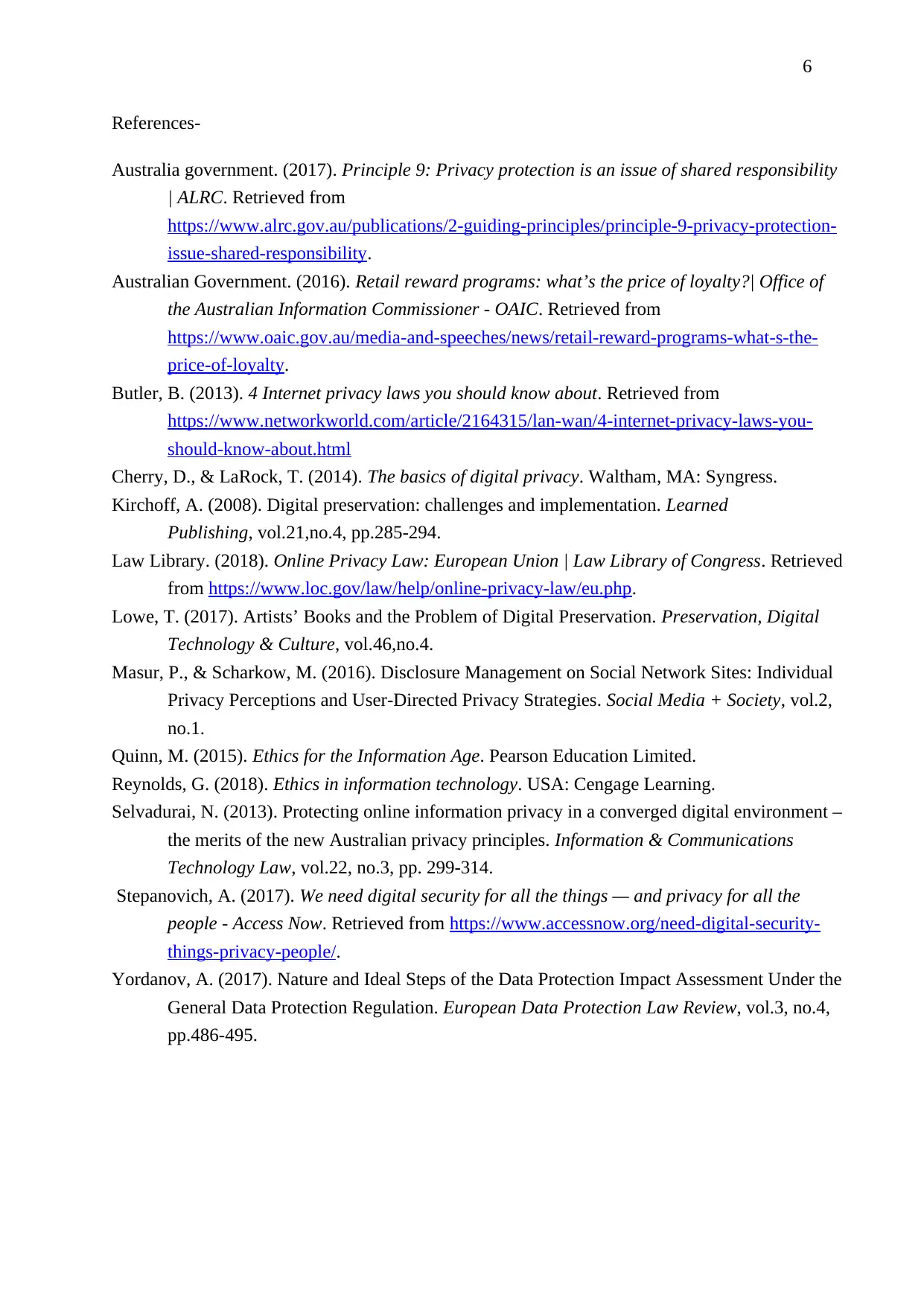
6
References-
Australia government. (2017). Principle 9: Privacy protection is an issue of shared responsibility
| ALRC. Retrieved from
https://www.alrc.gov.au/publications/2-guiding-principles/principle-9-privacy-protection-
issue-shared-responsibility.
Australian Government. (2016). Retail reward programs: what’s the price of loyalty?| Office of
the Australian Information Commissioner - OAIC. Retrieved from
https://www.oaic.gov.au/media-and-speeches/news/retail-reward-programs-what-s-the-
price-of-loyalty.
Butler, B. (2013). 4 Internet privacy laws you should know about. Retrieved from
https://www.networkworld.com/article/2164315/lan-wan/4-internet-privacy-laws-you-
should-know-about.html
Cherry, D., & LaRock, T. (2014). The basics of digital privacy. Waltham, MA: Syngress.
Kirchoff, A. (2008). Digital preservation: challenges and implementation. Learned
Publishing, vol.21,no.4, pp.285-294.
Law Library. (2018). Online Privacy Law: European Union | Law Library of Congress. Retrieved
from https://www.loc.gov/law/help/online-privacy-law/eu.php.
Lowe, T. (2017). Artists’ Books and the Problem of Digital Preservation. Preservation, Digital
Technology & Culture, vol.46,no.4.
Masur, P., & Scharkow, M. (2016). Disclosure Management on Social Network Sites: Individual
Privacy Perceptions and User-Directed Privacy Strategies. Social Media + Society, vol.2,
no.1.
Quinn, M. (2015). Ethics for the Information Age. Pearson Education Limited.
Reynolds, G. (2018). Ethics in information technology. USA: Cengage Learning.
Selvadurai, N. (2013). Protecting online information privacy in a converged digital environment –
the merits of the new Australian privacy principles. Information & Communications
Technology Law, vol.22, no.3, pp. 299-314.
Stepanovich, A. (2017). We need digital security for all the things — and privacy for all the
people - Access Now. Retrieved from https://www.accessnow.org/need-digital-security-
things-privacy-people/.
Yordanov, A. (2017). Nature and Ideal Steps of the Data Protection Impact Assessment Under the
General Data Protection Regulation. European Data Protection Law Review, vol.3, no.4,
pp.486-495.
References-
Australia government. (2017). Principle 9: Privacy protection is an issue of shared responsibility
| ALRC. Retrieved from
https://www.alrc.gov.au/publications/2-guiding-principles/principle-9-privacy-protection-
issue-shared-responsibility.
Australian Government. (2016). Retail reward programs: what’s the price of loyalty?| Office of
the Australian Information Commissioner - OAIC. Retrieved from
https://www.oaic.gov.au/media-and-speeches/news/retail-reward-programs-what-s-the-
price-of-loyalty.
Butler, B. (2013). 4 Internet privacy laws you should know about. Retrieved from
https://www.networkworld.com/article/2164315/lan-wan/4-internet-privacy-laws-you-
should-know-about.html
Cherry, D., & LaRock, T. (2014). The basics of digital privacy. Waltham, MA: Syngress.
Kirchoff, A. (2008). Digital preservation: challenges and implementation. Learned
Publishing, vol.21,no.4, pp.285-294.
Law Library. (2018). Online Privacy Law: European Union | Law Library of Congress. Retrieved
from https://www.loc.gov/law/help/online-privacy-law/eu.php.
Lowe, T. (2017). Artists’ Books and the Problem of Digital Preservation. Preservation, Digital
Technology & Culture, vol.46,no.4.
Masur, P., & Scharkow, M. (2016). Disclosure Management on Social Network Sites: Individual
Privacy Perceptions and User-Directed Privacy Strategies. Social Media + Society, vol.2,
no.1.
Quinn, M. (2015). Ethics for the Information Age. Pearson Education Limited.
Reynolds, G. (2018). Ethics in information technology. USA: Cengage Learning.
Selvadurai, N. (2013). Protecting online information privacy in a converged digital environment –
the merits of the new Australian privacy principles. Information & Communications
Technology Law, vol.22, no.3, pp. 299-314.
Stepanovich, A. (2017). We need digital security for all the things — and privacy for all the
people - Access Now. Retrieved from https://www.accessnow.org/need-digital-security-
things-privacy-people/.
Yordanov, A. (2017). Nature and Ideal Steps of the Data Protection Impact Assessment Under the
General Data Protection Regulation. European Data Protection Law Review, vol.3, no.4,
pp.486-495.
⊘ This is a preview!⊘
Do you want full access?
Subscribe today to unlock all pages.

Trusted by 1+ million students worldwide
1 out of 6
Related Documents
Your All-in-One AI-Powered Toolkit for Academic Success.
+13062052269
info@desklib.com
Available 24*7 on WhatsApp / Email
![[object Object]](/_next/static/media/star-bottom.7253800d.svg)
Unlock your academic potential
Copyright © 2020–2025 A2Z Services. All Rights Reserved. Developed and managed by ZUCOL.





